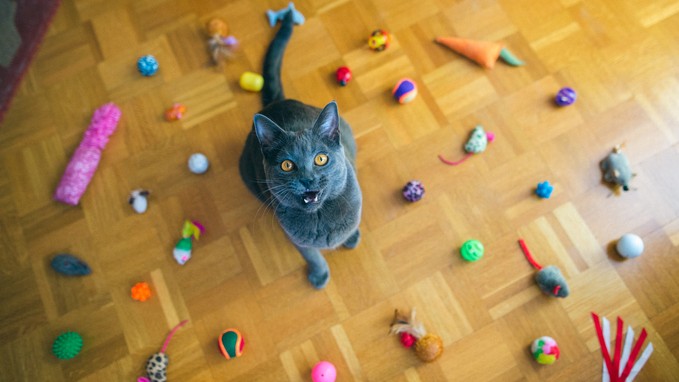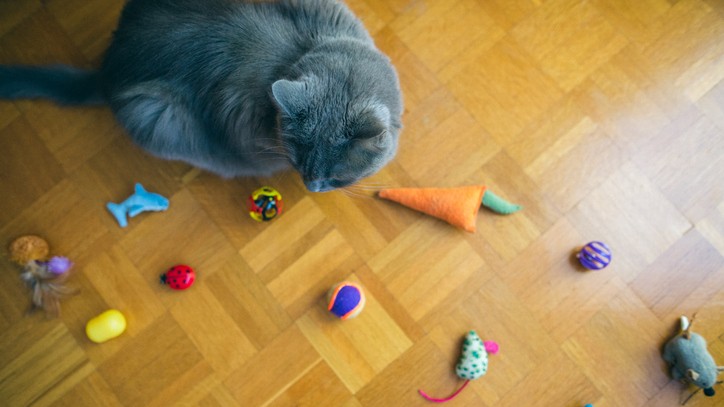Which cat toys are best for your cat? Find out what to pick
Knowing which cat toys are best can be tricky, with so many available. Here's how to narrow down the shopping list…

Knowing which cat toys are best is a tricky proposition, what with there being so many thousands of products out there, of varying quality. But it's a decision that needs to be made: cats are very sociable, and need to be played with regularly and kept engaged to keep them happy.
Things like cat scratching posts or the best automated cat toys can make all the difference to your furry feline.
At the same time, they can be very picky, who has spent loads on an epic-sized cat tower, only to see their cat ignore it in favor of the box it came in, can testify. Research has shown that cats vary hugely in their preferences – both in terms of the types of toy they prefer, and how long they spend playing with it.
To a degree, working out your cat's preferred kind of toy is a case of trial and error, but these tips should help you along. You can also read our guide to the best cat toys for additional paws for thought…

Recreate the hunt
Despite living alongside us for centuries, cats still have strong hunting instincts. Watch a litter of kittens at play and you’ll see them practicing their stalking, jumping, pouncing and catching skills.
According to Cats Protection, “the drive to hunt is not because they are hungry, but because hunting activity – the stalk, pounce, play and kill – releases feel-good hormones called endorphins. The best games encourage cats to stalk, pounce, chase and bat objects with a paw in a safe way”.
While there’s no guarantee a cat will like a new toy, you’ll probably have the most success with toys that look like prey or mimic a small animal’s movements. Materials such as feathers, wool or synthetic fur might help a cat to get in the zone and imagine it’s out hunting for food.
Get the best advice, tips and top tech for your beloved Pets
For other cats, a squeaker or a material that produces a crinkling sound may be more effective. Some cats will chase anything moving on the end of a string, no matter what it looks or sounds like.
Try out a few different toys and a variety of ways of moving them to pinpoint exactly what it is that excites your cat. You can use homemade toys for this experiment before you spend money on anything else (you may even find that you’ve created the perfect toy for your cat and don’t need to go shopping).
Once you’ve figured out how to bring out their inner hunter, you’ll have a better idea of the types of toy to look out for.
Toys you can play with together are great for bonding and for encouraging as much movement as possible, but you won’t always be in the house when your cat wants to play. It’s worth finding a couple of toys that are safe to be left out without supervision and get your cat practicing pouncing and batting on their own.
Balls and simple plastic or wooden puzzle toys will present enough of a challenge to keep them entertained without the risk of any parts being chewed or shredded. Puzzles can often be stocked with a handful of treats too, letting your cat have a snack while you’re out and making the game even more enticing.
- Is your cat bored? 10 tips to entertain your moggy
- Six reasons you should play with your cat right now
- Catit Play Treat Puzzle review

Safety first
Safety is just as important as fun when buying a new cat toy. All the materials and attachments should be safe for cats, and the toy should be constructed well so none of the components pose a choking risk. Don’t be dazzled by the look of a toy – fluffy bits and sequins might make a product appealing, but there’s a chance your cat will get their claws caught or accidentally ingest a small part if it comes off.
Shopping in-store allows you to take a closer look at a toy’s construction. Make sure the toy is an appropriate size for your cat, inspect the materials to assess their quality and tug components to check they’re securely attached.
Looking for cat toys online offers you a huge amount more choice, but makes it harder to check what you’re buying. Be wary of bargain sites or brand names you’re not familiar with. They may be completely legitimate, but there are also sites that use photos of other companies’ products to sell cheaper, poorly made versions.
Check reviews – if other customers say a toy was poor quality, or that parts fell off during play, avoid it and be wary of the seller. This is important even if you’re shopping with a familiar brand; sometimes there are faults or mistakes in a toy’s production, making a product from an otherwise trustworthy company dangerous.
When a new toy arrives, be sure to carry out the same checks you would in a store. If anything about the item seems off or sub-standard, it’s best to send it back. Inspect the toy again after your cat has played with it for the first time to make sure nothing has broken or come loose.

Try something new
On some occasions, the best toy for your cat is simply the one that’s unlike anything else they have. Cats can easily lose interest in toys easily, to keeping a level of variety is important.
Keep an eye out for toys with some you know your cat goes for – like a noise or particular theme. One example: if your cat used to love a fishing-pole toy, but has lost interest, roll a ball across the floor, or maybe even utilize a motorized toy.
But there's no need to get them a new toy every week. Once you have a collection, there's a simple of way of making sure they don't get bored: don't let them play with them all at once.
Try rotating the toys they have on offer every few days. This keeps playtime exciting, and allows you to introduce a brand-new one only when you feel like treating them or an existing toy is reaching the end of its life.
You know best
Hopefully, this advice has pointed you in the right direction in your search for the perfect cat toy. Remember; no one knows your cat like you do – if something catches your eye and you have a feeling they will like it, trust your instinct.
Find toys you both enjoy playing with and getting your cat active will never feel like a chore. Our list of the five best toys for indoor cats will give you some more ideas for feline fun.
References:
• Social interaction, food, scent or toys? A formal assessment of domestic pet and shelter cats
Victoria is a writer, author and communicator with a background in science and has recently completed an MSc in Science Communication. She also has a degree in Evolutionary Biology and has written for magazines including World of Animals, How It Works and Science+Nature. She grew up with rabbits and a spaniel, and has had her horse, Bernie, for 11 years.

